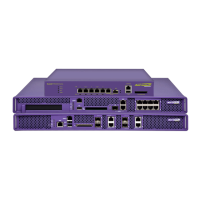Controller Services
Summit WM3000 Series Controller System Reference Guide270
Configuring Controller Redundancy and Clustering
Configuration and network monitoring are two tasks a network administrator faces as a network grows
in terms of the number of managed nodes (controllers, routers, wireless devices etc.). Such scalability
requirements lead network administrators to look for managing and monitoring each node from a
single centralized management entity. The controller not only provides a centralized management
solution, it provides centralized management from any single controller in the network without
restricting or dedicating one controller as a centralized management node. This eliminates dedicating a
management entity to manage all redundancy members and eliminates the possibility of a single point
of failure.
A redundancy group (cluster) is a set of controllers (nodes) uniquely identified by group/cluster ID.
Within the redundancy group, members discover and establish connections to other group members.
The redundancy group has full mesh connectivity using TCP as the transport layer connection.
Up to 12 controllers can be configured as members of a redundancy group to significantly reduce the
chance of a disruption in service to WLANs and associated MUs in the event of failure of a controller or
intermediate network failure. All members can be configured using a common file (cluster-config) using
DHCP options. This functionality provides an alternative method for configuring members collectively
from a centralized location, instead of configuring specific redundancy parameters on individual
controllers.
Configure each controller in the cluster by logging in to one participating controller. The administrator
does not need to login to each redundancy group member, as one predicating controller can configure
each member in real-time without “pushing” configurations between controllers. A new CLI context
called cluster-cli is available to set the configuration for all members of the cluster. All controller CLI
commands are considered cluster configurable.
In the following example, there are four controllers (WS1, WS2, WS3 and WS4) forming a redundancy
group. Each controller has established a TCP connection with the others in the group. There is an
additional CLI context called cluster-context. A user/administrator can get into this context by
executing a cluster-cli enable under the CLI interface (future releases will have this support in the Web UI
and SNMP interfaces). When the user executes this command on WS1, WS1 creates a virtual session
with the other controllers in the redundancy group (WS2, WS3 and WS4). Once the virtual session is
created, any command executed on WS1 is executed on the other controllers at the same time. This is
done by the cluster-protocol running on WS1, by duplicating the commands and sending them to the
group over the virtual connection:

